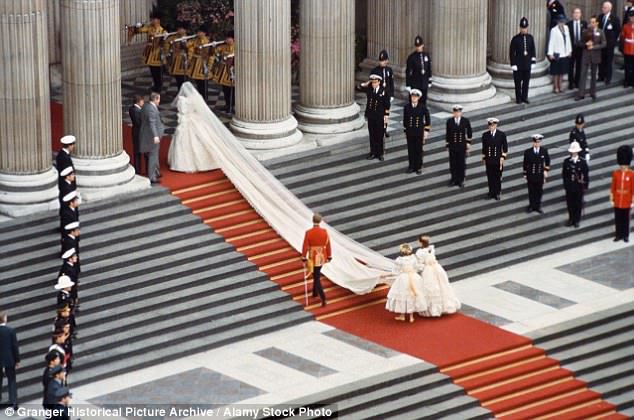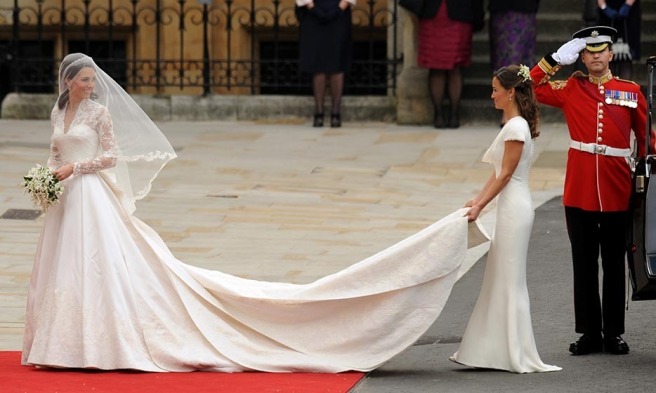
If you’re anything like me, then you’ll love a royal wedding! The extravagance, the tradition, the guest list and the fashions, fascinates not only me, but many around the world. Royal weddings have become a huge event, especially now that they are televised for the world to see. We as humble mortals get a glimpse inside the life and riches of the Royal Family, and can feel like we are somehow involved in this grandest of occasions. With all the hype and commotion surrounding the recent nuptials of Prince Harry and Meghan Markle, I have been inspired to take a look back at other royal weddings that have also had just as much impact. From Queen Elizabeth 2nd through Princess Diana, the Duchess of Cambridge and now the Duchess of Sussex, in this blog I’m going to explore the fashion trends and styles that marked these four grand weddings with not only a place in history, but a prestigious association with fashion history also.
I’ve had a fascination with the Royal Family for some years now. While they have certainly had their faux pars over the years, the new generation of Royal’s are doing great things and lending their popularity and influence to many wonderful causes. I’m not entirely sure when or where my love for the Royal’s began, but I suspect it has something to do with my Grandparents being British. My Grandfather especially had a strong passion for his home land, and I can remember him often speaking of the Royal Family with fondness. I guess this is also where my attachment towards British television drama came from (think Downton Abbey, The Crown, The Young Victoria). So let’s take a wander down the aisle of fashion history and discover what these royal brides and their outfits were really made from!

Britain was thrown into a flurry of excitement, when on 9th July 1947, the Royal Family announced the engagement of Queen Elizabeth 2nd (1926 – ) to Lieutenant Phillip Mountbatten RN. The royal engagement could not have come at a better time, lifting the spirits of all after the perils of war were finally over. Only five months later the couple wed in the grandest of churches, Westminster Abbey. The dress which Queen Elizabeth wore was commissioned for her by British designer Norman Hartnell. Hartnell was asked to submit several design to the Royal Family so they could make their decision if he was fit for the role. With less than three months to construct the dress, Hartnell got straight to work. He ordered more than 10,000 pearls from America to embellish the gown with. To keep the secrecy that must be attained with all royal wedding gowns, Hartnell had to paint the windows of his work room so that no prying eyes could see the master tailor at work. The dress was a one piece, princess style, and displayed a fitted bodice with a scalloped neckline. It was made from the purest of satin, with buttons and loops running the length of the bodice. The skirt, cut on the cross, had a circular train that extended to fifteen feet long. Modest compared to some! Keeping with tradition, long sleeves were a must. The gown was embroidered with white roses, diamantes and pearls, and a long veil crowned with a diamond tiara finished the brides outfit. Queen Elizabeth’s bridesmaid’s dresses were also made by Hartnell from ivory silk tulle. This was another tradition amongst royal weddings, where the bridesmaids replicated the colour and design of the bride’s gown, unlike modern wedding where you more often than not see colour splashed amongst the bridal party. Queen Elizabeth’s wedding dress was nothing short of epic, as too were the royal brides to follow over the next sixty years.


Over thirty years later we saw the royal wedding of Queen Elizabeth 2nd son, Prince Charles, the Prince of Wales. He wed a society girl Lady Diana Spencer (1961 – 1997), in what has been reported years later as a marriage of convenience and necessity rather that one based on love and affection. But the wedding ceremony of these two on July 2nd 1981, was one of the biggest the Royal Family has ever put on. Choosing to marry at St Paul’s Cathedral due to its sheer size to hold thousands of guest, Prince Charles and Lady Diana had their wedding televised for the world to see. In what seemed like the ultimate fairy tale, the bride was nothing short of extraordinary in her gown of ivory silk. David and Elizabeth Emmanuel were the designers chosen for the occasion, with Lady Diana also wearing one of their creations in her official engagement photographs. Unlike recent royal weddings, the designer of Lady Diana’s dress was announced to the press before the occasion. Again the design had to be kept secret, with the Emmanuel’s also painting the windows of their studio to keep an air of mystery about it all. No sketches of the dress were made either. The design which was seen for the first time as Lady Diana stepped from her carriage, comprised of a fitted bodice with a deep flounce neckline. Full sleeves were dominant and a crinoline petticoat ensured the meters of fabric in the skirt were on display. A blue bow was sewn into the waistband of the dress, and an ivory silk tulle veil with mother of pearl sequins sat perfectly atop the new Princess’ head. And there is no mistaking the twenty five foot long train that this dress encompassed, cascading down the aisle of St Paul’s Cathedral in all its royal glory! The five bridesmaid’s that accompanied Lady Diana were outfitted in a similar style but in a lighter weight fabric. An icon of fashion in the eighties, the memories that Diana, Princess of Wales created on that brilliant day in July will always remain as an important part of fashion history.


Then in 2011, we saw the wedding of Prince Charles’ and Diana’s eldest son, Prince William of Wales. He wed is university sweetheart Catherine Middleton (1982 – ), in a lavish ceremony to rival that of his parents some years earlier. At Westminster Abbey on 29th April 2011, the Prince and his new Duchess were married amongst thousands of guest in a televised event for the world to see. The bride chose Sarah Burton of Alexander McQueen to design her gown, and also the stunning dress in which her Maid of Honour wore. In Ivory satin, the gown paid homage to royal tradition with a long sleeve of stunning lace work. This lace work was entirely hand made, and showcased flora of the British Empire, including roses, thistle and shamrock. The bodice of the dress was boned to keep its figure hugging silhouette, with padding over the hips to ensure a smooth flow from the stunning full skirt that fell below. The train was a modest nine foot long, and a Cartier halo tiara sat atop the Duchess’ head from the Queen’s own private collection. As tradition with many royal weddings, the brides’ bouquet was placed on the tomb of the Unknown Warrior after the completion of the ceremony.


The most recent royal wedding that we all saw differed in many ways from the tradition and grandeur of those before it. With a more relaxed vibe, Prince Henry (Harry) of Wales married his American fiancé Meghan Markle (1981 – ) at St Georges Chapel, Windsor on 19th May 2018. As with William and Kate’s wedding, the speculation mounted as to who the designer of the brides’ gown would be. As Meghan emerged from her bridal car, the world was informed that it was in fact British born Claire Waight Keller, who was now the creative director of French label Givenchy. The bride had been overwhelmed with submissions from designers around the world wanting to make her dress, but Meghan chose the elegant and timeless style of Givenchy. With the gown being constructed in both Paris and London, Meghan had eight fittings in the three months that were allotted to construct the dress. With a wide boat neck, long sleeve and tailored bodice, the bride looked stunning in a gown simular to some Givenchy himself had designed for Audrey Hepburn many years before. The colour was pure white, and the bridesmaids’ outfits were also made by Waight Keller. A diamond bandeau tiara borrowed from the Queen held Meghan’s veil in place, with the centre brooch of the tiara dating back to 1893. It took five hundred hours to construct the silk tulle veil, longer than it took to make the dress! It was completely hand maid, with the fifty three flora emblems of the Commonwealth countries being embroidered onto it. The seamstresses working on the veil had to wash their hands every thirty minutes to ensure its pure white colour was not soiled.

It may be a few years now until we see another royal wedding on the scale of the ones we have seen over the last sixty years. When the time does however come, you can be sure that tradition will still play a major role. A royal wedding dress will always draw attention, no matter who the bride is.
Love Always, Anastacia Rose xx

